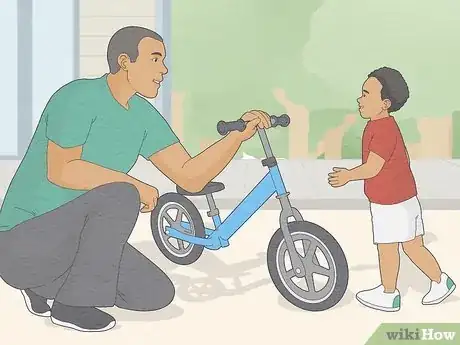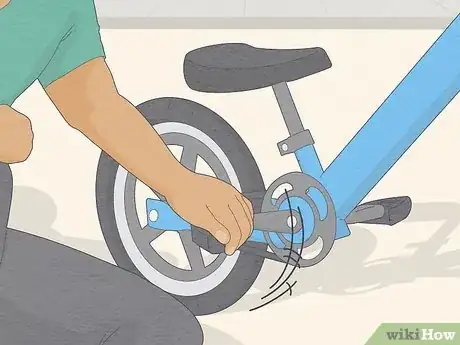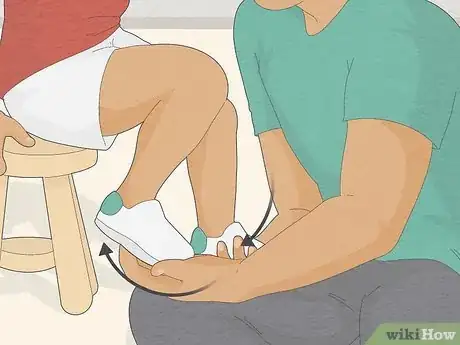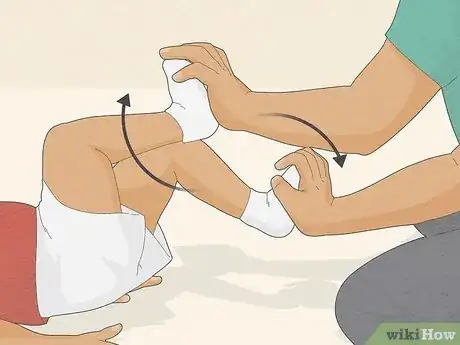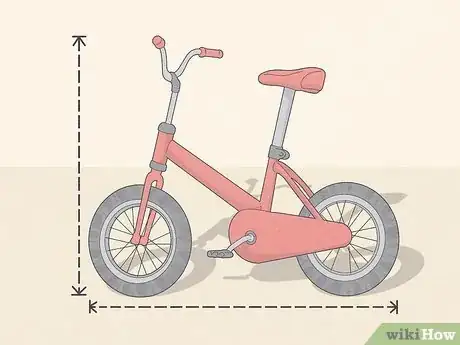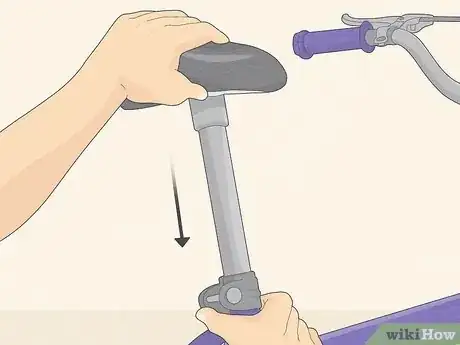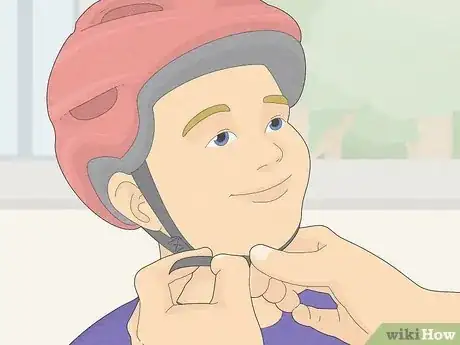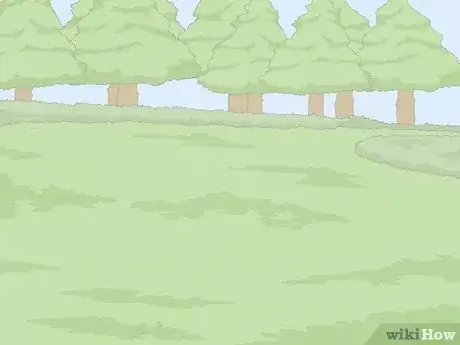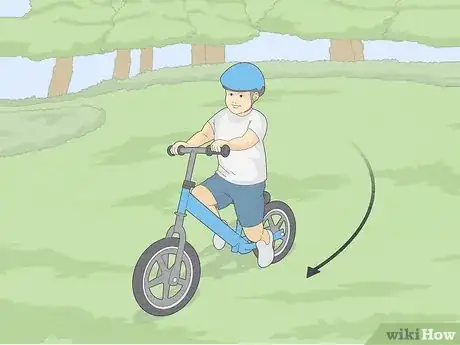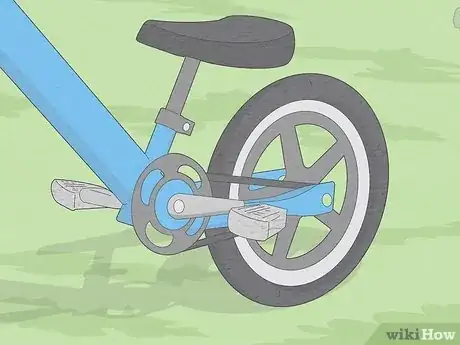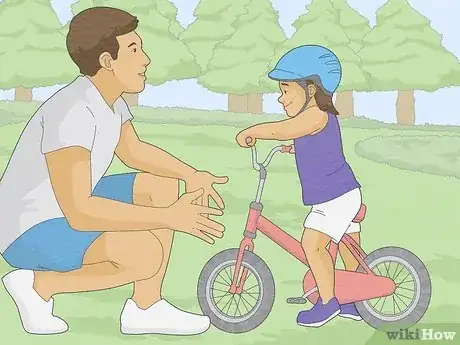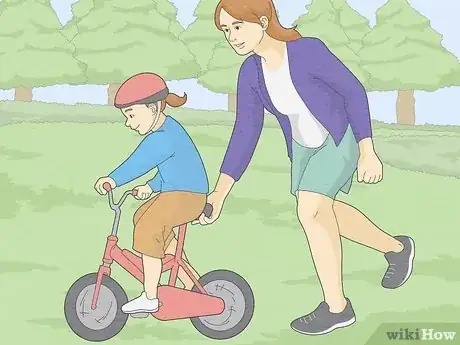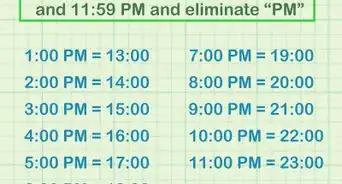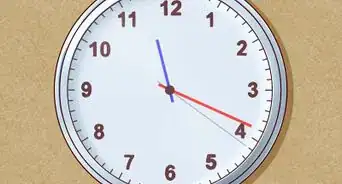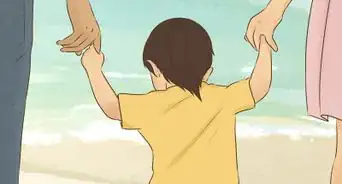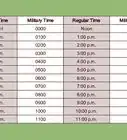This article was co-authored by Jonas Jackel. Jonas Jackel is the Owner of Huckleberry Bicycles, a bicycle retail store based in San Francisco, California. Jonas has over 20 years of experience managing bicycle retail stores and has operated Huckleberry Bicycles since 2011. Huckleberry Bicycles specializes in servicing, repairing, and custom building road, cross, gravel, touring, folding, and e-bikes. Jonas was also previously sat on the Board of Directors for Bike East Bay, a bicycle-advocacy non-profit organization based in Oakland, California.
There are 8 references cited in this article, which can be found at the bottom of the page.
This article has been viewed 143,825 times.
Teaching your child to pedal a bike is an exciting, and challenging, endeavor. However, wikiHow is here to help you introduce your child to the concept of pedalling, adjust the bike so that your child feels comfortable, and ultimately teach your child how to pedal.
Steps
Introducing Your Child to Pedalling
-
1Introduce your child to the bicycle. While you do not need to go into detail explaining what each part of the bike does, it does help to give your child an idea of what they will be riding around on. Bring your child’s bike out and set it up so that your child can look at it.
- Point out where your child will sit, where the pedals are, and how the wheels move.
- Plan to begin teaching your child how to pedal when they are between three and six years old. If you show your child how the pedals work before the age of three, they might not understand your instructions.
-
2Demonstrate the action of pedaling. Put your foot or hand on the pedal and make the pedal rotate in order to show your child how the pedal works. Point out that when the pedal moves, the wheels also move. Let your child push the pedals with their hands so they can begin to get a feel for the movement.
- Hold the bike up while you do this so that the wheels can move freely and your child can see the bike in action.
Advertisement -
3Have your child practice pedalling on your hands. Have your child sit in a chair that is roughly the same height as the bike seat. Sit across from your child, facing them. Put your palms at the height of the pedals and have your child place a foot in each of your palms.
- Now push your child’s feet up and down in the same movement that she would do if they were pedaling.
- Once they have gotten a feel for the movement, have your child ‘pedal’ with your hands.
-
4Have your child practice with their legs. Ask your child to lie down on the floor. Lie down across from them so that the bottoms of your feet are touching the bottoms of their feet. Put your feet up in the air (with their feet still touching yours) and begin to pedal like you would on a bike.
- Have your child try to push your feet in a pedalling motion to help them gain the strength they will need to push the pedals on the real bike.
-
5Demonstrate pedalling using your own bike. Sit on your bike and slowly pedal so that your child can see how you move your legs (and how the wheels move because of the pedalling you are doing).
- Try to pedal slowly at first, and then more quickly as your child gains a better understanding of what you are doing.
-
6Let your child watch other children ride their bikes. Bring your child to a park where other kids ride bikes. Watching their peers may help your child to compartmentalize the process of pedalling.
Adjusting the Bike
-
1Choose the right size of bike. Because your child is a toddler, they should have a toddler-sized bike. If the bike is too big, your child won’t be able to reach the pedals, so take them to pick out the bike when you purchase it.[1] To determine if the bike is the right size:[2] :
- Help your child to get on to the bike. Have them stand above the top pipe of the frame with both feet on the ground. If they can do this comfortably, the bike is the appropriate size.
-
2Adjust the seat height. Seat height is very important for proper pedaling. Begin by putting the bike seat at its lowest level so that your child can practice pushing the bike (rather than pedalling). Once your child is ready to start pedalling, adjust the seat so that it is consistent with their height.[3]
- To determine the seat height, make sure that your child can reach the pedal with her whole foot when the pedal is the lowest position.
-
3Put a helmet on your child. It is very likely that your child will tip over or fall off the bike while they learn how to pedal. Because of this, a helmet is of the utmost importance.[4]
- Fit the helmet so that when it is strapped to your child’s head, it doesn’t wiggle very much, but is also not glued to your child’s head.
- The helmet should also sit level across your child’s forehead.
- Consider have them use knee and elbow pads along with a helmet as they get older.
Helping Your Child to Practice Pedalling
-
1Consider putting training wheels on your child’s bike. If your child is very scared of falling, consider helping them by putting training wheels on their bike so that they can practice pedalling without the fear of falling.
- Once they have mastered riding the bike with training wheels, take the training wheels off and proceed to the next step.
-
2Select a grassy area with no traffic. Grass is good to practice on because it provides a cushion for when your child falls while they practice pedalling.
- Pick a spot that has a gentle slope to it to help your child practice going up and downhill.
-
3Have your child practice going downhill without pedalling. The hill should decline just enough that the bike can roll without your child pedalling it. You can even take the pedals off of the bike to help your child practice. Instruct your child to avoid touching the ground with their feet until they make it down the hill. Doing this will help them to gain a sense of balance.[5]
- Once your child can go down the hill comfortably, put the pedals back on and have your child place their feet on the pedals. Instruct them to avoid pedalling, but instead to just go down the hill with their feet on the pedals.
-
4Set the pedal up so your child can start pedalling without training wheels. Bring your child (and the bike) to a flat surface. Have your child get on to the bike, with one foot on the ground holding them up. Bring one pedal up so that it's at its tallest height and ready for your child to place their foot on it and start pedalling.[6]
- Explain again that the bike will begin to move when they press the pedal down with their foot.
-
5Explain the act of pedalling on each alternate pedal. Explain that you need to push the pedal alternately. Show that when one pedal is up, the other is down. Explain that your child needs to push one pedal down first, and then push the other when down when it is at its highest point.[7]
- Remind them that the faster they pedal, the faster the bike will go.
-
6Hold on to your child while they practice pedalling. Hold on to the bike seat and have your child begin to pedal. Run behind or beside the bike while your child pedals on their own.[8]
- When they (and you) feel confident with her pedalling skills, allow them to try pedalling on her own. You can even give them a little push to help get their momentum going.
References
- ↑ Jonas Jackel. Bicycle Shop Owner. Expert Interview. 18 February 2020.
- ↑ http://www.rei.com/learn/expert-advice/teach-child-to-ride-a-bike.html
- ↑ Jonas Jackel. Bicycle Shop Owner. Expert Interview. 18 February 2020.
- ↑ http://www.rei.com/learn/expert-advice/teach-child-to-ride-a-bike.html
- ↑ http://www.bhg.com/health-family/activities/games/how-to-learn-to-ride-a-bike-in-15-minutes/
- ↑ https://www.twowheelingtots.com/how-to-teach-a-child-to-ride-a-balance-bike/
- ↑ https://activeforlife.com/how-to-teach-kids-to-pedal-their-bikes-properly/
- ↑ http://www.rei.com/learn/expert-advice/teach-child-to-ride-a-bike.html
- https://living.thebump.com/teach-child-pedal-bike-16532.html
Expert Q&A
Did you know you can get expert answers for this article?
Unlock expert answers by supporting wikiHow
-
QuestionHow high should the seat be if they're just starting out?
 Jonas JackelJonas Jackel is the Owner of Huckleberry Bicycles, a bicycle retail store based in San Francisco, California. Jonas has over 20 years of experience managing bicycle retail stores and has operated Huckleberry Bicycles since 2011. Huckleberry Bicycles specializes in servicing, repairing, and custom building road, cross, gravel, touring, folding, and e-bikes. Jonas was also previously sat on the Board of Directors for Bike East Bay, a bicycle-advocacy non-profit organization based in Oakland, California.
Jonas JackelJonas Jackel is the Owner of Huckleberry Bicycles, a bicycle retail store based in San Francisco, California. Jonas has over 20 years of experience managing bicycle retail stores and has operated Huckleberry Bicycles since 2011. Huckleberry Bicycles specializes in servicing, repairing, and custom building road, cross, gravel, touring, folding, and e-bikes. Jonas was also previously sat on the Board of Directors for Bike East Bay, a bicycle-advocacy non-profit organization based in Oakland, California.
Owner, Huckleberry Bicycles
-
QuestionWhat is a good age to teach a child to ride a bike?
 Jonas JackelJonas Jackel is the Owner of Huckleberry Bicycles, a bicycle retail store based in San Francisco, California. Jonas has over 20 years of experience managing bicycle retail stores and has operated Huckleberry Bicycles since 2011. Huckleberry Bicycles specializes in servicing, repairing, and custom building road, cross, gravel, touring, folding, and e-bikes. Jonas was also previously sat on the Board of Directors for Bike East Bay, a bicycle-advocacy non-profit organization based in Oakland, California.
Jonas JackelJonas Jackel is the Owner of Huckleberry Bicycles, a bicycle retail store based in San Francisco, California. Jonas has over 20 years of experience managing bicycle retail stores and has operated Huckleberry Bicycles since 2011. Huckleberry Bicycles specializes in servicing, repairing, and custom building road, cross, gravel, touring, folding, and e-bikes. Jonas was also previously sat on the Board of Directors for Bike East Bay, a bicycle-advocacy non-profit organization based in Oakland, California.
Owner, Huckleberry Bicycles
-
QuestionAre training wheels as bad as everyone says?
 Jonas JackelJonas Jackel is the Owner of Huckleberry Bicycles, a bicycle retail store based in San Francisco, California. Jonas has over 20 years of experience managing bicycle retail stores and has operated Huckleberry Bicycles since 2011. Huckleberry Bicycles specializes in servicing, repairing, and custom building road, cross, gravel, touring, folding, and e-bikes. Jonas was also previously sat on the Board of Directors for Bike East Bay, a bicycle-advocacy non-profit organization based in Oakland, California.
Jonas JackelJonas Jackel is the Owner of Huckleberry Bicycles, a bicycle retail store based in San Francisco, California. Jonas has over 20 years of experience managing bicycle retail stores and has operated Huckleberry Bicycles since 2011. Huckleberry Bicycles specializes in servicing, repairing, and custom building road, cross, gravel, touring, folding, and e-bikes. Jonas was also previously sat on the Board of Directors for Bike East Bay, a bicycle-advocacy non-profit organization based in Oakland, California.
Owner, Huckleberry Bicycles
About This Article
To teach your toddler to pedal a bike, start by showing them the motion without a bike. Have them sit in a chair and use your hands to push your child’s feet like they’re pedaling. You can also have them lie on their back while you move their feet in a pedaling motion. It might help to show your child by riding your own bike slowly. Once they understand what to do, take them to a grassy area to practice on their own bike. You can hold the bike under the seat to help them balance. Or, if your child’s scared of falling off, fit training wheels to their bike until they get used to pedaling. For more tips, including how to adjust your child’s bike to suit them, read on!
